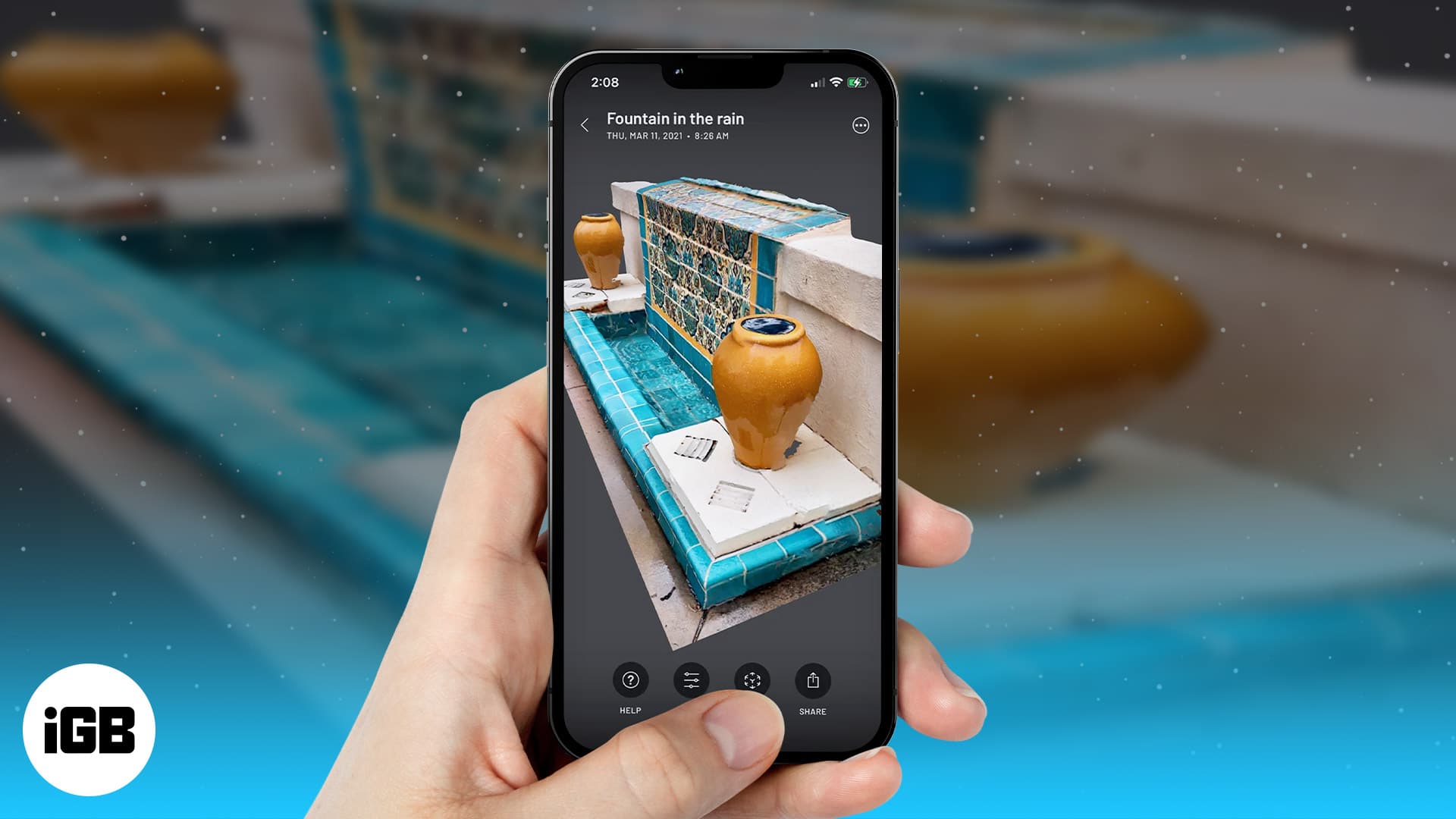Table of Contents
Things you need to know:
- Currently, the LiDAR (Light Detection And Ranging) sensor is only available on iPhone 12 Pro, 12 Pro Max, 13 Pro, 13 Pro Max, iPad Pro 2020, and M1-powered iPad Pro 2021.
- My top 3 apps are:
- Snapchat – Create AR effects
- Measure – Helps you measure objects and people’s height quickly
- Microsoft’s Seeing AI – Helpful for the visually impaired to recognize nearby things
Apple has been adding the LiDAR sensor to its latest iPhone and iPad lineup since 2020. The LiDAR sensor scans objects and surroundings to create 3D data. Besides, it hints at Apple’s plan to expand on the AR front in the future! However, what if I said you aren’t using it to the fullest? I have discovered the best LiDAR apps for iPhone and iPad to help you unleash its full potential.
Note: If you want to know more about this cool sensor, check out our article on LiDAR and how it works.
- Snapchat
- Measure
- Seeing AI
- Scaniverse
- IKEA Place
- LiDAR Pointer
- SiteScape
- RC Club
- Room Planner
- Canvas for Homeowners
1. Snapchat – Editor’s choice

Snapchat is a popular messaging app used around the world. The app is widely loved for its built-in camera filters and streaks. When Apple brought the LiDAR sensor to iPhones, Snapchat was one of the first apps to add filters using the sensor’s capabilities.
Snapchat uses LiDAR to scan the environment and load the filter in real-time. Some of these filters were demonstrated during the iPhone 12 event. To use these filters, type LiDAR in Search, and you are good to go! Moreover, a person can even develop filters of their own using Snap’s Lens Studio.
Pros
- Lots of LiDAR filters to try
- Easy navigation
- Ability to share images or videos with friends
- Popular social media platform
Cons
- ‘Discover’ section should have improved content quality
Price: Free
2. Measure – Measure objects and people

As the name suggests, the Measure app is used for measurements. Other than that, you can also set water levels using this app. One thing that I liked about it is that you can set two points anywhere and measure the distance between them both vertically and horizontally. The app also shows the middle point between two points.
Additionally, the app automatically measures a rectangle and even a person’s height. Not only that, you can take images of these measurements and share them with anyone you want.
Further, the integration of haptics in the app improves the experience. It also stores past measurements so that you can copy and paste them elsewhere. And lastly, all the features in the app are completely free to use and will work even offline!
Pros
- Easy to use UI
- Ability to store previous measurements
- Great haptics
- Works offline
- Measure a person’s height
Cons
- Could have added the option to choose different measurement units
- Height measurement isn’t as accurate
Price: Free
3. Seeing AI – Best for visually impaired

Developed by Microsoft to help the blind and low vision community, Seeing AI uses the power of AI to recognize the objects around it and describes them to the user. Although this app supports older iPhone models like iPhone 6S, SE, and above, it can recognize objects much more easily with the power of LiDAR.
Seeing AI can recognize short text, documents, products, people, scenes, currency, color, handwriting, and even light intensity. Even though the app is doing pretty good with its current features, I think the devs can improve the app UI and AI in recognizing objects.
Pros
- Simple UI
- Recognizes lots of things
- Frequent updates
- AI works mostly well in recognition
Cons
- AI recognition could have been better
Price: Free
4. Scaniverse – Scan the world

Scaniverse is a great app for 3D scans using an iPhone with LiDAR. The app can make highly detailed 3D scans that can be shared with others or viewed in 3D or AR. Moreover, the models are highly accurate, that you can export them to popular formats like FBX, OBJ, USDZ, and LAS for 3D modeling software.
Another feature that I liked in the app is its ability to measure between points after the scan. You can measure between any points in the scans, add filters, and make other required changes according to your preference.
Pros
- Highly detailed scans
- Easy to understand UI
- No need to create an account to access features
- Free to use
- Export models into multiple formats
Cons
- Detailed scans can be time consuming
Price: Free
5. IKEA Place – Smart home designing

The IKEA Place is a quick, fun, and hassle-free app where you can try the furniture from the IKEA store in the comfort of your home. With this app, you can virtually place the furniture of your choice anywhere you want and make purchase decisions accordingly.
My experience with the 3D furniture placement through AR was great. IKEA promises 98% accuracy in scaling virtual furniture based on its surroundings. You can also use the finder to take pictures of any furniture or product you like to see similar ones available at the IKEA store.
But that doesn’t mean the app is free of issues. While the app has an easy and understandable UI, it still lacks a search option other than the image search. Moreover, the app’s availability is limited to only a few regions, and not all products have 3D support.
Pros
- Simple and easy UI
- Ability to capture images and search for similar products
- Works well for supported products
- Categories are sorted between Collections and Categories
Cons
- No search feature other than image search
- App not available in every region
- Some products are not available in AR
Price: Free
6. LiDAR Pointer – Point and measure

LiDAR Pointer is another measurement app on our list. It can also measure angles other than the regular distance measurement. This app uses the LiDAR sensor to measure the distance between your phone and the object you are pointing at. It also works offline and is free to use.
While it is said that when you double-tap the screen, the app will speak the distance, it was not working for some reason when I tested it. So can’t comment on its effectiveness. I hope the developers will fix the issue with the next update!
However, unlike the Measure app, LiDAR Pointer can neither measure custom points nor have haptic feedback. Although people have given it a low rating on the App Store for some reason, it is indeed a good app and worth trying!
Pros
- Easy and minimal UI
- Can also measure angles
- Works offline
- Free to use
Cons
- The double-tap to speak feature was not working
Price: Free
7. SiteScape – 3D scan from your pocket

Sitescape is mainly helpful in the architectural, engineering, and construction fields. The app can create 3D scans in real-time and can later be used to transfer to any CAD software. You can also measure the location after scanning.
Other than professional use, ordinary people can also use SiteScape to create 3D scans to keep the memory of their favorite place or just for fun. The only thing that annoyed me was the need to have an account to export the scans. However, it’s worth creating a SiteScape account as you also get cloud storage for scans.
Pros
- Ability to control the intensity of scans
- Can do 3D scans in real-time
- The free version is good for most users
- Fun to do 3D scans
- Offer cloud storage for scans
Cons
- Account required to export the files
- Need improvements regarding the details captured
Price: Free (In-app purchase starts at $49.99)
8. RC Club – A super fun game

I put this app below in the list because the developers haven’t brought any updates to the app since 2020. Like some other apps in the list, RC Club will work on iPhones without LiDAR but works better on those with the sensor. You will have a great time with the game if you get past the initial learning curve.
The game comes with some great features even without any in-app purchases. The only issue I encountered was controlling myself from playing the game so that I could focus on this article!
Even if you are an adult or a kid, I’m pretty sure you will enjoy the time with this game. At least I enjoyed every minute of playing it. Another thing that I liked about this game is how well the haptics are integrated into it. You will only know how good it is when trying it in real.
I hope that the developers will soon develop a new update to improve the game’s overall experience.
Pros
- Haptics are integrated well with the game
- Great haptics
- Enjoyable for both kids and adults
- The game is enjoyable even without in-app purchases
Cons
- Not been updated for a long time
- Has a learning curve
Price: Free (In-app purchases start at $0.99)
9. Room Planner – Design your home

With Room Planner, you can design your home anytime or anywhere. You can either scan the room, use the predefined shapes, or set your own. There is also an option to edit the size of the room later. After creating the room, you can carry forward by adding furniture or see the floor plan to check how it looks.
If you run out of ideas, you can look for inspiration in its community section. The only thing that annoyed me was the full-screen banner asking to subscribe to the premium plan every time I opened the app.
Yes, the premium plan comes with its benefits, including more furniture and designs to choose from and the option to create multiple rooms. But for the most part, the free plan comes with enough features and options that you may not need to subscribe to premium unless you are using them for commercial purposes.
Pros
- Ability to make room plans according to your choice
- Make changes to the floor plan after creating it
- Can add furniture of your choice
- View rooms in 2D and 3D
Cons
- You get an ad for the app’s premium plan every time you open the app
- You have to pay for more furniture variety
- Sometimes the content may not load even after having good internet
Price: Free (In-app purchases start at $5.99)
10. Canvas for Homeowners – Scan anywhere

Canvas for Homeowners is a great app to plan and customize your home. While there are some useful features with the basic free version, most of the app’s main features, including the ability to process scans to CAD, are placed behind the in-app purchase wall.
Canvas is good for those who want to see the site without visiting it. I like its ability to do highly detailed scans of any surroundings you throw at it. If your use case is only for once or twice, the price of the premium plan may sound expensive.
The basic free features include measuring between two points, adding comments, and viewing the scans from different perspectives. Although you can use this app on iPhones without LiDAR support, iPhones with LiDAR increases the scanning speed 5x.
Pros
- Detailed scans
- Ability to view the scans through different perspectives
- Can view the scans in AR
- Feature to measure or add comments to the scans.
Cons
- In-app purchases are expensive
Price: Free (File format conversion starts at $0.10 per sqft)
Many apps with camera access use LiDAR to improve the output. Other than that, if you want to use the capabilities of LiDAR, you can try Snapchat, Measure, Seeing AI, Scaniverse, and IKEA Place.
Using the LiDAR on iPad is as easy as using the cameras. All you have to do is point out the object with the LiDAR-supported app on your iPad.
Yes, the LiDAR used in the latest Pro series of iPhones and iPads come with the same LiDAR sensor.
Using LiDAR is the same as using the camera in iPhones. All you have to do is open any app that supports LiDAR.
Signing off…
LiDAR is a new sensor that Apple has begun to add with the Pro versions of the latest iPhones and iPads. App developers have already begun to bring useful apps based on this sensor, and I have tried to cover the best among them.
By the way, which one do you like the most? Do let me know in the comments below.
Since you have come all the way here, these are also worth a read:






More Stories
Natural Tactics to Overcome Depression Without Medication
Celebrating Milestones Forward Can Yield Amazing Results
Radar Trends to Watch: July 2022 – O’Reilly